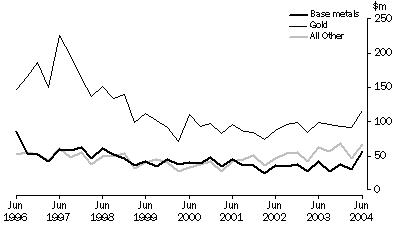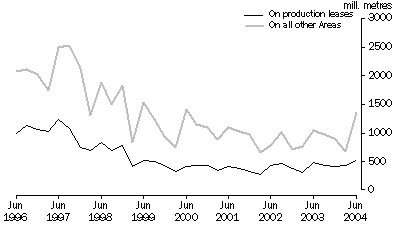CHANGES TO THIS ISSUE
There are no changes in this issue.
CHANGES TO NEXT ISSUE
For the past four quarters, the ABS has been collecting mineral exploration expenditure on "greenfields" and "brownfields" sites in response to user feedback. From next quarter's issue, this release will include this new disaggregation of expenditure in place of the current split by production leases and other areas. Collection of data on exploration on production leases and other areas will also cease. Next quarter's issue will contain information on differences between the former and new disaggregation.
INQUIRIES
For further information about these and related statistics, contact the National Information and Referral Service on 1300 135 070 or Fiona Cotsell on Sydney (02) 9268 4357.
SUMMARY OF FINDINGS
MINERAL EXPLORATION (OTHER THAN FOR PETROLEUM)
TREND ESTIMATES
The trend estimate for total mineral exploration expenditure increased by 6.6% to $214.6m in the June quarter 2004. The estimate has risen in the last three quarters and is now 17.4% higher than the June quarter 2003.
All states recorded slight increases this quarter except for Victoria which had a small decrease. Western Australia had the largest increase of $8.2m (6.9%).
The trend estimate for metres drilled has been increasing steadily for the past three quarters. The current estimate is now 17.0% higher than the June quarter estimate for last year.
MINERAL EXPLORATION (OTHER THAN FOR PETROLEUM)
EXPLORATION EXPENDITURE
The seasonally adjusted estimate of mineral exploration expenditure increased by $18.2m or 9.1% this quarter (up 43.6% in original terms). This increase was dominated by exploration in areas other than production leases, which increased by $70.4m (57.8%) in original terms. Expenditure on production leases increased $2.6m (5.7%) in original terms.
Seasonally adjusted expenditure in most states and territories increased this quarter, with Western Australia having the largest increase of $17m or 14.9%. Victoria (down 32.7%) and the Northern Territory (down 7.8%) had the only decreases.
In original terms, exploration for all minerals increased this quarter, except for the category of other minerals. The largest increases came from expenditure on gold (up $24.9m, 27.3%, with most of the increase coming from Western Australia) and nickel and cobalt (up $16.0m, 103.2%).
Mineral exploration expenditure, Original series

MINERAL EXPLORATION (OTHER THAN FOR PETROLEUM)
METRES DRILLED
In seasonally adjusted terms, total metres drilled increased by 20.8% in the June quarter 2004 (up 70.0% in original terms). The increase was dominated by drilling in areas other than production leases.
Metres Drilled, Original series

PETROLEUM EXPLORATION EXPENDITURE
OVERVIEW
As expected, petroleum exploration expenditure returned to near-normal levels in June quarter 2004, after low levels in the March quarter. The March quarter downturn has, however, resulted in expenditure for the six months to June 2004 being relatively low. Expectations for the six months to December 2004 are higher than expectations for the comparable period in 2003.
Expenditure on petroleum exploration for the June quarter 2004 increased by $87.6m (51.9%) to $256.4m.
Expenditure on exploration on both production leases (up $18.7m or 87.4%) and all other areas (up $68.9m or 46.7%) increased this quarter.
Offshore exploration had a strong increase of $83.3m (72.0%), while onshore exploration expenditure increased by $4.2m (7.9%).
REGIONAL DATA
In the June quarter 2004 most states recorded slight decreases in expenditure, but these were offset by Western Australia which recorded a large increase of $90.6m (84.8%). The only other state to show an increase was Tasmania, which rose by $3.4m (425.0%).
 Print Page
Print Page
 Print All
Print All